The global remote imaging collaboration market is projected to grow from USD 4,213.6 million in 2025 to approximately USD 6,733.9 million by 2035, recording an absolute increase of USD 2,520.3 million over the forecast period. This translates into a total growth of 59.8%, with the market forecast to expand at a compound annual growth rate (CAGR) of 4.8% between 2025 and 2035.
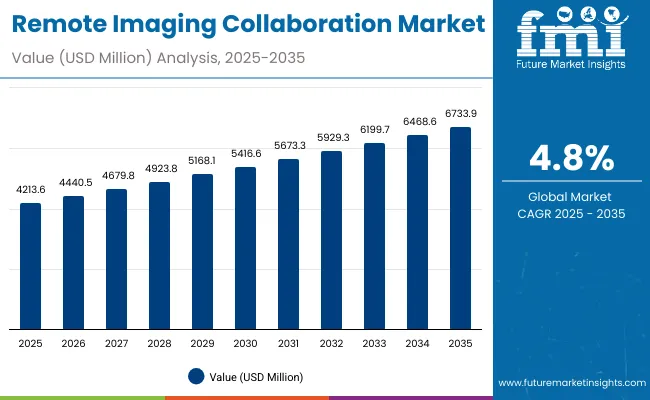
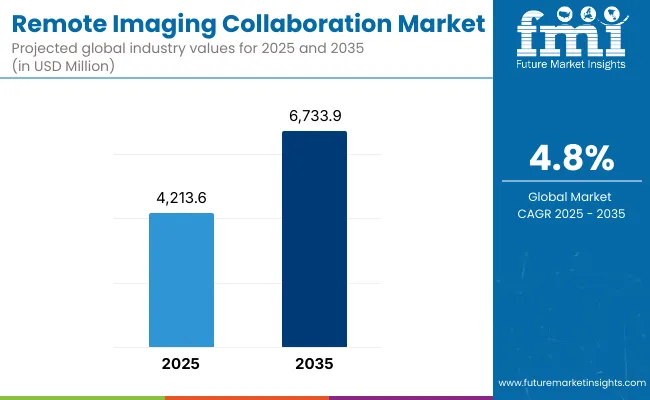
Remote Imaging Collaboration Market Key Takeaways
| Metric | Value |
|---|---|
| Estimated Value in (2025E) | USD 4,213.6 million |
| Forecast Value in (2035F) | USD 6,733.9 million |
| Forecast CAGR (2025 to 2035) | 4.8% |
The overall market size is expected to grow by nearly 1.6X during the same period, supported by increasing adoption of cloud-based imaging solutions, rising demand for remote diagnostics, and growing focus on healthcare digitization and telemedicine integration.
Between 2025 and 2030, the remote imaging collaboration market is projected to expand from USD 4,213.6 million to USD 5,326.7 million, resulting in a value increase of USD 1,113.1 million, which represents 44.2% of the total forecast growth for the decade.
This phase of growth will be shaped by rising adoption of telemedicine platforms, increasing demand for remote diagnostic capabilities, and growing penetration of cloud-based imaging solutions in emerging markets. Healthcare organizations are expanding their remote imaging collaboration portfolios to address the growing demand for efficient diagnostic workflows and cross-institutional collaboration.
From 2030 to 2035, the market is forecast to grow from USD 5,326.7 million to USD 6,733.9 million, adding another USD 1,407.2 million, which constitutes 55.8% of the overall ten-year expansion. This period is expected to be characterized by expansion of hybrid deployment models, integration of artificial intelligence with imaging collaboration platforms, and development of advanced workflow optimization solutions.
The growing adoption of evidence-based radiology and healthcare provider recommendations will drive demand for clinically proven remote imaging collaboration solutions with enhanced efficiency and diagnostic accuracy.
Between 2020 and 2025, the remote imaging collaboration market experienced significant expansion, driven by increasing recognition of remote healthcare delivery needs and growing acceptance of telemedicine approaches.
The market developed as healthcare providers recognized the need for comprehensive imaging collaboration solutions to address complex diagnostic requirements and cross-institutional workflows. Clinical research and regulatory approvals began emphasizing the importance of remote imaging platforms in achieving better patient outcomes and operational efficiency.
Market expansion is being supported by the increasing demand for remote diagnostic capabilities and the corresponding need for more efficient imaging workflow solutions. Modern healthcare providers are increasingly focused on collaboration platforms that can facilitate cross-institutional consultations, improve diagnostic turnaround times, and reduce the burden of traditional imaging workflows.
The proven efficacy of remote imaging solutions in improving access to specialized radiological expertise and reducing healthcare costs makes them essential components of comprehensive healthcare delivery systems.
The growing emphasis on digital health transformation and precision medicine is driving demand for advanced imaging collaboration platforms that address institutional needs and workflow optimization requirements. Healthcare provider preference for scalable solutions that combine multiple imaging modalities and collaboration features in unified platforms is creating opportunities for innovative technology development.
The rising influence of value-based care models and evidence-based diagnostic protocols is also contributing to increased adoption of proven remote imaging collaboration solutions across different healthcare settings and therapeutic areas.
The market is segmented by component, modality, deployment mode, and region. By component, the market is divided into software platforms, services, and hardware/infrastructure. Based on modality, the market is categorized into X-Ray, Computed Tomography (CT), Magnetic Resonance Imaging (MRI), Ultrasound, Mammography, Nuclear Imaging (PET, SPECT), and others. In terms of deployment mode, the market is segmented into cloud-based, on-premises, and hybrid. Regionally, the market is divided into North America, Europe, Asia Pacific, Latin America, and Middle East & Africa.
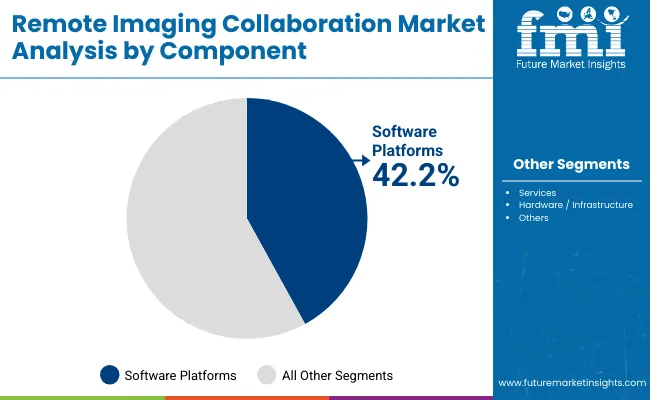
The software platforms segment is projected to account for 42.2% of the remote imaging collaboration market in 2025, reaffirming its position as the category's dominant component. Healthcare providers increasingly recognize the critical importance of robust software infrastructure for enabling seamless image sharing, real-time collaboration, and advanced diagnostic workflows. This component addresses core functionality requirements including image processing, workflow management, and multi-institutional connectivity.
This component forms the foundation of most remote imaging implementations, as it represents the most technologically advanced and functionally comprehensive approach to imaging collaboration. Regulatory compliance and extensive clinical validation continue to strengthen confidence in these platforms.
With increasing recognition of the complexity of modern radiology workflows requiring multi-modal and multi-institutional approaches, software platforms align with both operational efficiency and clinical effectiveness goals. Their broad utility across multiple imaging modalities ensures sustained market dominance, making them the central growth driver of remote imaging collaboration demand.
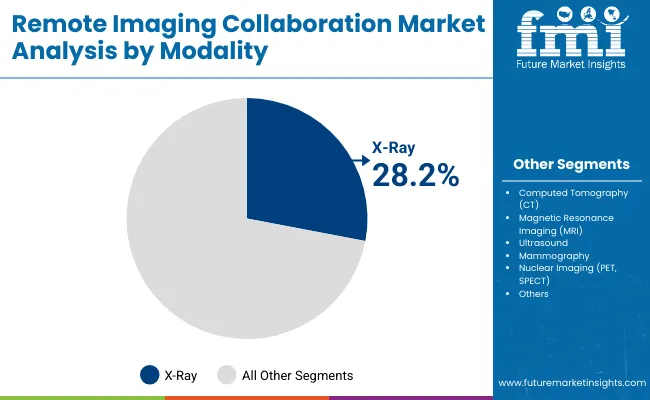
X-Ray is projected to represent 28.2% of remote imaging collaboration demand in 2025, underscoring its role as the primary imaging modality driving remote collaboration adoption. Healthcare providers recognize that X-Ray imaging's widespread availability, cost-effectiveness, and fundamental diagnostic importance make it ideally suited for remote consultation and collaborative interpretation. The modality's established workflow patterns and standardized protocols facilitate seamless integration with remote collaboration platforms.
The segment is supported by the ubiquitous nature of X-Ray imaging requiring consistent expert interpretation and the growing recognition that remote collaboration can improve diagnostic accuracy and reduce interpretation turnaround times.
Additionally, healthcare systems are increasingly adopting evidence-based imaging guidelines that leverage remote expertise for optimal diagnostic outcomes. As clinical understanding of X-Ray interpretation complexity advances, remote collaboration solutions will continue to play a crucial role in comprehensive diagnostic strategies, reinforcing their essential position within the imaging collaboration market.
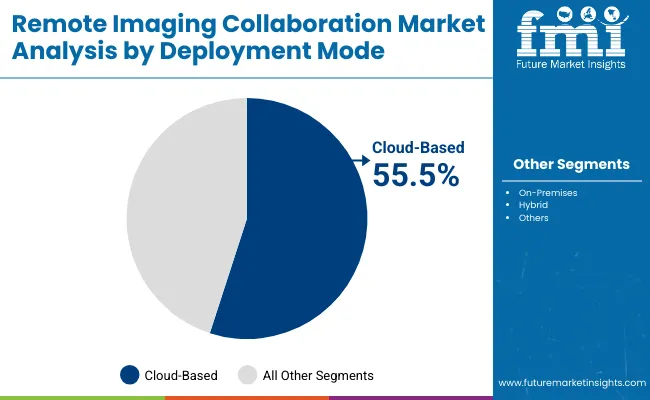
The cloud-based deployment mode is forecasted to contribute 55.5% of the remote imaging collaboration market in 2025, reflecting the primary preference of healthcare organizations for scalable, accessible, and cost-effective imaging collaboration solutions.
Healthcare institutions rely on cloud-based platforms for their flexibility, reduced infrastructure requirements, and ability to facilitate seamless multi-site collaboration, making cloud deployment the cornerstone of modern imaging collaboration strategies. This deployment mode provides essential advantages including automatic updates, scalability, and reduced IT overhead.
The segment benefits from established relationships between healthcare organizations and cloud service providers, who offer comprehensive security, compliance, and performance guarantees. Cloud-based solutions also provide advantages in terms of accessibility from multiple locations, integration with existing healthcare IT systems, and cost-effectiveness through subscription-based pricing models.
With growing emphasis on digital health transformation and multi-institutional collaboration, cloud-based deployment serves as the critical enabler for remote imaging collaboration, making it the fundamental driver of market accessibility and growth.
The remote imaging collaboration market is advancing steadily due to increasing recognition of remote healthcare delivery needs and growing demand for comprehensive diagnostic collaboration approaches. However, the market faces challenges including complex regulatory compliance requirements, data security concerns, and challenges related to integration with legacy imaging systems. Innovation in cloud-based platforms and AI-enhanced collaboration tools continue to influence product development and market expansion patterns.
Expansion of Hybrid Deployment Models and Multi-Institutional Networks
The growing adoption of hybrid deployment strategies is enabling more sophisticated imaging collaboration management that combines the benefits of cloud accessibility with on-premises security and control. Hybrid solutions offer comprehensive workflow management capabilities, including advanced security protocols and compliance monitoring, that are particularly important for complex multi-institutional collaboration requirements. Multi-institutional networks provide access to specialized radiological expertise and enable optimized resource utilization across healthcare systems.
Integration of Artificial Intelligence and Advanced Analytics Platforms
Modern imaging collaboration companies are incorporating artificial intelligence technologies such as automated image analysis, workflow optimization algorithms, and predictive analytics to enhance collaboration platform capabilities. These technologies improve diagnostic accuracy, enable real-time quality assessment, and provide better coordination between radiologists and referring physicians. Advanced AI platforms also enable personalized workflow recommendations and early identification of potential diagnostic challenges or urgent cases.
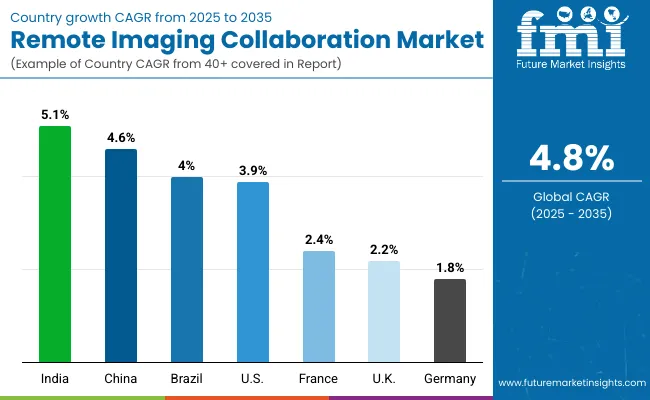
| Country | CAGR (2025 to 2035) |
|---|---|
| India | 5.1% |
| China | 4.6% |
| Brazil | 4.0% |
| USA | 3.9% |
| France | 2.4% |
| U.K. | 2.2% |
| Germany | 1.8% |
The remote imaging collaboration market is experiencing varied growth globally, with India leading at a 5.1% CAGR through 2035, driven by expanding healthcare infrastructure, increasing adoption of digital health technologies, and growing access to telemedicine platforms. China follows at 4.6%, supported by healthcare digitization initiatives, increasing recognition of remote diagnostics importance, and expanding healthcare technology coverage. Brazil shows growth at 4.0%, emphasizing improved access to radiological expertise and remote collaboration platform adoption.
The USA records 3.9% growth, focusing on value-based care models and comprehensive imaging workflow optimization. Europe shows 2.5% growth, representing established markets with mature imaging collaboration frameworks and regulatory compliance requirements.
The report covers an in-depth analysis of 40+ countries; eight top-performing countries are highlighted below.
Revenue from remote imaging collaboration in China is projected to exhibit steady growth with a CAGR of 4.6% through 2035, driven by ongoing healthcare digitization initiatives and increasing recognition of telemedicine as a priority healthcare delivery method.
The country's expanding healthcare technology infrastructure and growing availability of specialized radiological services are creating significant opportunities for remote collaboration platform adoption. Major international and domestic technology companies are establishing comprehensive distribution networks to serve the growing population of healthcare institutions requiring advanced imaging collaboration across urban and developing regions.
Revenue from remote imaging collaboration in India is expanding at a CAGR of 5.1%, supported by increasing healthcare accessibility, growing digital health awareness, and expanding technology market presence. The country's large healthcare provider network and increasing recognition of telemedicine benefits are driving demand for effective remote collaboration solutions. International technology companies and domestic developers are establishing distribution channels to serve the growing demand for quality imaging collaboration platforms.
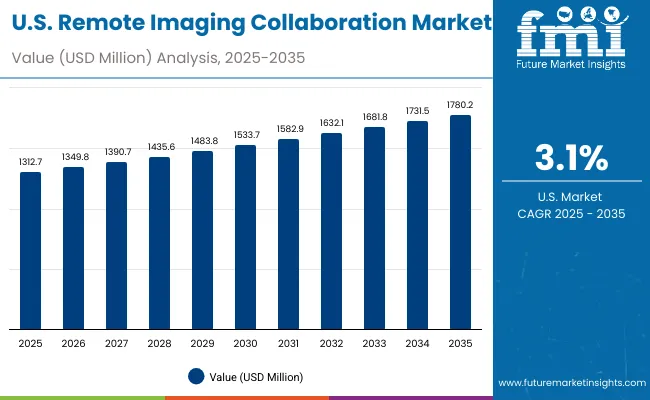
Demand for remote imaging collaboration in the USA is projected to grow at a CAGR of 3.9%, supported by well-established healthcare technology systems and evidence-based imaging workflow guidelines. American healthcare providers consistently utilize remote collaboration platforms for complex diagnostic cases and multi-institutional consultations. The market is characterized by mature implementation protocols, comprehensive regulatory compliance frameworks, and established relationships between healthcare organizations and technology companies.
Revenue from remote imaging collaboration in Brazil is projected to grow at a CAGR of 4.0% through 2035, driven by healthcare system development, increasing access to digital health technologies, and growing recognition of telemedicine importance. Brazilian healthcare providers are increasingly adopting remote collaboration approaches for complex imaging cases, supported by expanding technology market presence and improved platform accessibility.
Revenue from remote imaging collaboration in the U.K. is projected to grow at a CAGR of 2.2% through 2035, supported by the National Health Service framework and comprehensive evidence-based imaging guidelines that facilitate appropriate use of remote collaboration platforms for complex diagnostic workflows. British healthcare providers consistently utilize established protocols for remote collaboration management, emphasizing clinical outcomes and operational optimization within integrated care systems.
Revenue from remote imaging collaboration in Germany is projected to grow at a CAGR of 1.8% through 2035, supported by the country's well-established healthcare technology infrastructure, comprehensive regulatory compliance, and systematic approach to imaging workflow management. German healthcare providers emphasize evidence-based remote collaboration platform utilization within structured healthcare frameworks that prioritize clinical effectiveness and data security.
Revenue from remote imaging collaboration in France is projected to grow at a CAGR of 2.4% through 2035, supported by the country's comprehensive healthcare system, established radiology infrastructure, and systematic approach to digital health integration. French healthcare providers emphasize evidence-based remote collaboration platform utilization within integrated care frameworks that prioritize diagnostic quality and workflow continuity.
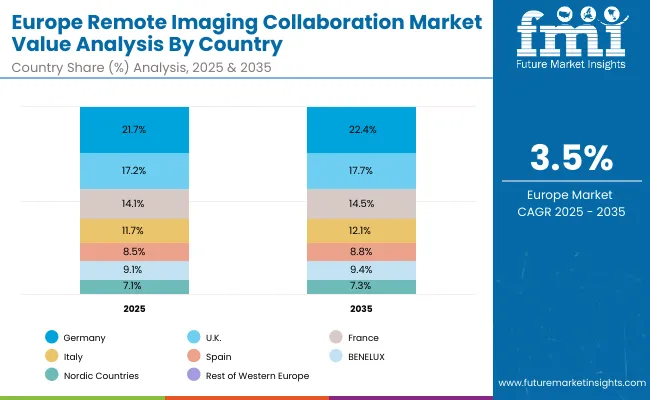
The remote imaging collaboration market in Europe is projected to expand steadily through 2035, supported by increasing adoption of digital health technologies, rising prevalence of cross-institutional diagnostic collaboration needs, and ongoing clinical innovation in imaging workflow optimization.
Germany will continue to lead the regional market, accounting for 21.7% in 2025 and rising to 22.4% by 2035, supported by a strong healthcare technology base, regulatory compliance frameworks, and robust imaging infrastructure. The United Kingdom follows with 17.2% in 2025, increasing to 17.7% by 2035, driven by NHS adoption of advanced imaging guidelines, digital health integration, and broadening specialist networks.
France holds 14.1% in 2025, edging up to 14.5% by 2035 as healthcare institutions expand remote collaboration protocols and demand grows for optimized imaging workflows. Italy contributes 11.7% in 2025, growing to 12.1% by 2035, supported by strong regional healthcare programs and growing technology adoption participation. Spain represents 8.5% in 2025, increasing to 8.8% by 2035, underpinned by strengthening access to digital health services and institutional collaboration programs.
BENELUX markets together account for 9.1% in 2025, moving to 9.4% by 2035, supported by innovation-friendly regulatory frameworks and academic-industry collaboration. The Nordic countries represent 7.1% in 2025, marginally increasing to 7.3% by 2035, with demand fueled by progressive healthcare systems and early adoption of evidence-based imaging collaboration platforms. The Rest of Western Europe moderates from 10.6% in 2025 to 7.8% by 2035, as larger core markets capture a greater share of investment, technology implementation, and adoption of remote collaboration protocols.
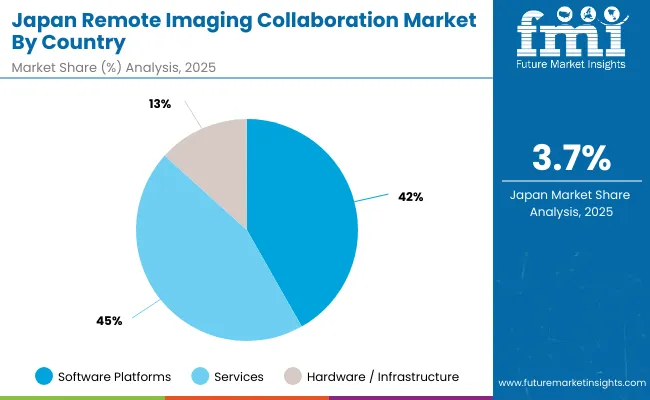
The remote imaging collaboration market in Japan is set to remain diversified across several component categories in 2025, reflecting clinical preferences in healthcare technology adoption and evolving implementation patterns. Software Platforms dominate with a 41.8% share in 2025, supported by their central role in enabling comprehensive imaging workflows, multi-institutional connectivity, and advanced diagnostic collaboration capabilities.
Services represent 44.9% in 2025, gaining prominence from growing demand for implementation support, training programs, and ongoing technical assistance for remote collaboration platforms. Hardware/Infrastructure holds 13.3%, sustained by the essential requirements for robust network connectivity, data storage solutions, and specialized imaging equipment integration.
The distribution reflects Japan's systematic approach to healthcare technology implementation, emphasizing comprehensive service support alongside advanced software capabilities, while maintaining necessary infrastructure investments to ensure optimal platform performance and regulatory compliance.

The remote imaging collaboration market in South Korea in 2025 is shaped by strong demand across core imaging modalities, reflecting both clinical utilization patterns and technological infrastructure capabilities. X-Ray accounts for the largest share at 27.9%, supported by its widespread availability, cost-effectiveness, and fundamental role in primary diagnostic workflows requiring remote consultation and collaborative interpretation.
Computed Tomography (CT) follows with 24.3%, driven by the complexity of CT interpretation, increasing utilization in emergency and specialty care, and growing demand for remote radiological expertise. Magnetic Resonance Imaging (MRI) contributes 18.3%, supported by the specialized expertise required for MRI interpretation and the benefits of remote collaboration for complex cases.
Ultrasound holds 12.4%, reflecting growing adoption of point-of-care ultrasound and the need for remote guidance and quality assurance. Mammography contributes 7.5%, supported by screening programs and specialized expertise requirements. Nuclear Imaging (PET, SPECT) accounts for 6.1%, driven by specialized interpretation needs and limited local expertise. The remaining 3.5% is attributed to other imaging modalities, including emerging technologies and specialized applications, highlighting opportunities for expanded remote collaboration capabilities.
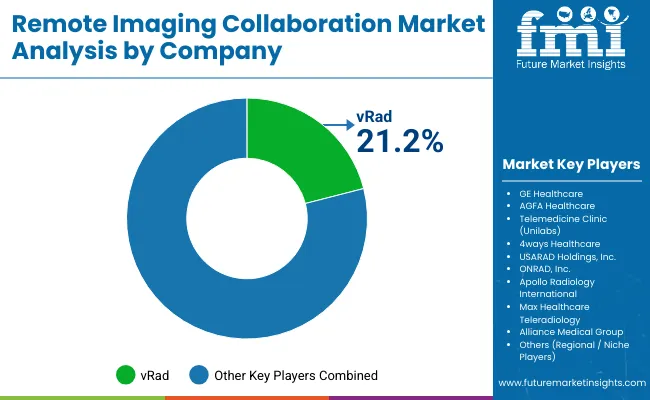
The remote imaging collaboration market is characterized by competition among established healthcare technology companies, specialized telemedicine focused firms, and comprehensive healthcare service providers. Companies are investing in platform development, regulatory compliance, strategic partnerships, and healthcare provider education to deliver effective, secure, and accessible remote imaging collaboration solutions. Technology development, clinical validation, and market access strategies are central to strengthening product portfolios and market presence.
vRad leads the market with 21.2% global value share, offering clinically-proven remote imaging collaboration platforms with a focus on diagnostic accuracy and workflow efficiency. GE Healthcare provides comprehensive imaging technology solutions with emphasis on integration and scalability. AGFA Healthcare focuses on innovative imaging informatics and specialized collaboration platforms for healthcare institutions. Telemedicine Clinic (Unilabs) delivers established telemedicine services with strong clinical evidence and healthcare provider acceptance.
4ways Healthcare operates with focus on bringing innovative remote collaboration solutions to diverse healthcare settings. USARAD Holdings Inc. provides comprehensive teleradiology services including remote collaboration platforms across multiple imaging modalities. ONRAD Inc. specializes in advanced imaging interpretation and collaboration solutions for complex diagnostic cases. Apollo Radiology International, Max Healthcare, and Teleradiology Alliance Medical Group provide specialized remote imaging services and collaboration platforms to enhance market accessibility and healthcare provider access to essential imaging expertise and workflow optimization solutions.
| Items | Values |
|---|---|
| Quantitative Units (2025) | USD 4,213.6 Million |
| Component | Software Platforms, Services, Hardware / Infrastructure |
| Modality | X-Ray, Computed Tomography (CT), Magnetic Resonance Imaging (MRI), Ultrasound, Mammography, Nuclear Imaging (PET, SPECT), Others |
| Deployment Mode | Cloud-Based, On-Premises, Hybrid |
| Regions Covered | North America, Europe, Asia Pacific, Latin America, Middle East & Africa |
| Countries Covered | United States, Germany, United Kingdom, France, China, Japan, South Korea, India, Brazil, and 40+ countries |
| Key Companies Profiled | vRad , GE Healthcare, AGFA Healthcare, Telemedicine Clinic ( Unilabs ), 4ways Healthcare, USARAD Holdings Inc., ONRAD Inc., Apollo Radiology International, Max Healthcare, Teleradiology Alliance Medical Group |
| Additional Attributes | Dollar sales by component and imaging modality, regional demand trends, competitive landscape, healthcare provider preferences for specific deployment modes, integration with healthcare IT systems, innovations in cloud-based platforms, workflow optimization capabilities, and diagnostic quality enhancement |
The global remote imaging collaboration market is valued at USD 4,213.6 million in 2025.
The size for the remote imaging collaboration market is projected to reach USD 6,733.9 million by 2035.
The remote imaging collaboration market is expected to grow at a 4.8% CAGR between 2025 and 2035.
The key offering segments in the remote imaging collaboration market are software platforms, professional services, and integrated solutions.
In terms of offering, software platforms segment is set to command 42.2% share in the remote imaging collaboration market in 2025.






Full Research Suite comprises of:
Market outlook & trends analysis
Interviews & case studies
Strategic recommendations
Vendor profiles & capabilities analysis
5-year forecasts
8 regions and 60+ country-level data splits
Market segment data splits
12 months of continuous data updates
DELIVERED AS:
PDF EXCEL ONLINE
Remote Lockout Tool Market Size and Share Forecast Outlook 2025 to 2035
Remote Desktop Software Market Forecast and Outlook 2025 to 2035
Remote Patient Monitoring Devices Market Size and Share Forecast Outlook 2025 to 2035
Remote Assist Headrest Market Size and Share Forecast Outlook 2025 to 2035
Remote Endarterectomy Devices Market Size and Share Forecast Outlook 2025 to 2035
Remote Electrocardiogram Monitoring Market Size and Share Forecast Outlook 2025 to 2035
Remote Valve Tissue Expanders Market Size and Share Forecast Outlook 2025 to 2035
Remote Patient Monitoring System Market Size and Share Forecast Outlook 2025 to 2035
Remote Operated Vehicle Market Size and Share Forecast Outlook 2025 to 2035
Remote DC Microgrid Market Size and Share Forecast Outlook 2025 to 2035
Remote Microgrid Market Size and Share Forecast Outlook 2025 to 2035
Remote Towers Market Size and Share Forecast Outlook 2025 to 2035
Remote AF Detection Tools Market Analysis Size and Share Forecast Outlook 2025 to 2035
Remote Vehicle Diagnostics Market Size and Share Forecast Outlook 2025 to 2035
Remote Home Monitoring Systems Market Size and Share Forecast Outlook 2025 to 2035
Remote Asset Management Market Size and Share Forecast Outlook 2025 to 2035
Remote Learning Technology Spending Market Analysis by Technology Software, Technology Services, Learning Mode, End User and Region Through 2025 to 2035
Remote Sensing Services Market Trends - Growth & Forecast 2025 to 2035
Remote Cooled Cube Ice Machines Market – Advanced Refrigeration & Industry Growth 2025 to 2035
Remote Healthcare Market - Growth & Innovations 2025 to 2035

Thank you!
You will receive an email from our Business Development Manager. Please be sure to check your SPAM/JUNK folder too.
Chat With
MaRIA